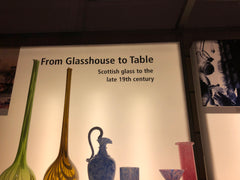Scottish Handmade Glass
Glass production was established in the 17th century in East Wemyss in Fife, with seaweed being used to produce the sodium element necessary for glassmaking. However, it was a woman (of course!) that started off the production of glass in Scotland on an industrial scale.

Lady Frances Erskine was born in 1715 in Alloa and was the daughter of John Erskine, The Earl of Mar. Her mother, Lady Mar, was also known as the Countess of Mar.
In 1750, Lady Erskine brought Bohemian glassmakers to Scotland from Europe and trained them to make glass for the thriving whisky trade in the area; as the industry encountered a boom period, more bottles were required for the liquid.

These skilled glassmakers supervised the construction of the first glass cone on the site of what was to become the Alloa Glassworks in Clackmannanshire. In so doing, the Bohemians brought their skills and knowledge of mass production of glass to the area. formulating some of the first mas produced whisky glasses.
Fast forward 75 years and the site was then owned by the Edinburgh, Glasgow and Alloa Glass Company. They built additional glass cones including the Northern Cone: a stone-built structure, standing at 90 feet tall, which housed a huge furnace within which were platforms all around for the glassblowers to stand on.
There are only four glass cone kilns of this type still in the United Kingdom. The glassworks sat on the edge of the River Forth estuary; an area which was rich in coal. The Northern Cone still stands as an historical structure and a monument to glassblowing.
The raw materials for glassmaking are sodium (salt) and silica (sand). Local salt was sourced from The River Forth and the sand was quarried from the Local Devilla Forest; the coal, which was required to fire the kilns, came directly from the Mar collieries.

These glassblowers were highly skilled and, in turn, trained apprentices to scale up production on blowing glass bottles. It was a very hot and labour-intensive process but, in the 17th century, glass was considered to be as valuable as silver.
Alloa became the hub of glass manufacture, lasting until the 1800s when industrial processes took over. At the same time, whisky production in Scotland was flowing. In its day, the profession of glassblower was a prestigious one and much sought-after.

The glassworks were owned by United Glass in the 20th century and now production continues under the owner ship of Owens Illinois, the world’s largest container manufacturer, based in the USA, and credited with introducing new technology in the mass production of glass bottle making. With rising energy costs and more efficient technology, they can produce glass more sustainably. It can produce up to 2 million bottles a day and employs over 500 staff. A far cry from the hand-crafted bottles produced almost 300 years ago.
Scotland really has a proud glassmaking heritage which we are hugely glad to be a part of.
Tom Young MBE, our Co-Founder & Master Glassblower, has pieces of his glassware in the Kelvingrove Art Gallery & Museum as a record of glassmaking in the 20th century; illustrating techniques from all glassware sectors: from design, medicine and manufacturing.
Kelvingrove Art Gallery and Museum opened in 1901 and is a firm favourite with local people and visitors. It has stunning architecture and a family friendly atmosphere. Explore the 22 galleries and discover everything from art to animals, Ancient Egypt to Charles Rennie Mackintosh and so much more. If you only have one day in Glasgow, Kelvingrove Art Gallery and Museum is a must see!


Glass has been an important part of Scotland's history for centuries. The earliest known examples of glass production in Scotland date back to the Roman period, when glass was used for a variety of purposes including making beads and other decorative items.
In the Middle Ages, the production of glass in Scotland increased, with the creation of window glass for castles and churches. However, the industry struggled to compete with imported glass from Europe and it wasn't until the 18th century that glass production in Scotland began to flourish.
During the Industrial Revolution, glass production in Scotland boomed, with the development of new techniques and technologies. The introduction of large-scale glass factories, such as the St. Rollox Glassworks in Glasgow, made it possible to produce glass on a large scale and at a much lower cost.
Today, Scotland is home to a number of glass manufacturers and artists who continue to work in this traditional material, and many of these companies still produce the traditional types of glass like leaded glass. Glass art is also an important part of the contemporary art scene in Scotland, with many artists using glass in their work.
The history of glass in Scotland has been an interesting one, and it is still an important part of the country's culture and economy today.
